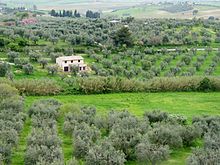Maremma
In Italian, the Maremma generally means swampy coastal land. The term is narrowed to the landscape in central Italy , which, according to a pars-pro-toto understanding that is common today, includes all of southern Tuscany and parts of northern Lazio . In a narrower sense, however, the Maremma only includes the flat coastal strip, interrupted by the chain of hills of the Monti dell'Uccellina, between the Gulf of Follonica , the rivers of the Bruna and Ombrone and the Orbetello lagoon on Monte Argentario , originally a contiguous stretch of coastline with the Tyrrhenian A swampy landscape connected to the sea , which in Roman times was called the Maritima Regio . The name of the landscape, which is related to the Spanish term marisma (= swampy coastal land), arose from this. Places in the Maremma therefore often have the epithet Marittima attached to the place name, even if they are not by the sea. The town of Talamone south of today's Uccellina Nature Park is of particular historical importance ; Talamone was the port of the free city of Siena during the Renaissance .
Creation of the landscape
In the flat landscape, the rivers bring more water from the mountains in winter than can drain into the sea. This creates extensive shallow inland lakes between the rivers that do not dry out even in summer. The wind piles up sand dunes between the waters, interspersed with large masses of rubble, boulders and broken branches that the rivers carry in front of them. The salt water of the sea and the fresh water of the rivers mix in a unique swamp landscape.
As is known from Roman sources, the Etruscans, who settled on the hills in today's hinterland ( Populonia , Vetulonia , Roselle ), succeeded in partially draining the bay by creating a system of canals that connected their settlements with the sea. But even in Roman times, the forces of nature regained the upper hand, and since late antiquity the country has been left to its own devices. Some cities that prospered in Roman times perished completely.
Malaria had been known in the swamps since the Middle Ages ; neither Pisa nor Siena showed any interest in the area other than as port bases for strategic purposes. Dante mentions the curse of the Maremma in his Divina Commedia Canto V. 133-136 of the Purgatorio (lament of the abandoned Countess Pia of Tolomei from Siena: “… Siena made me, the Maremma broke me”), and an old folk song tells of the “bitter Maremma”, which took away the love of the first-person narrator.
The recultivation and drainage program ( la bonifica )
It was not until the 18th and 19th centuries that the Grand Dukes of Tuscany initiated a comprehensive recultivation and drainage program for the country from the House of Habsburg-Lothringen. Ferdinand III. was the first to come up with the idea, but could no longer implement it because he himself died of malaria.
Since 1804 his son, Grand Duke Leopold II , and his advisor, Count Fossombroni, had designed plans for the construction of a canal system to drain off the sediment-rich river water and return the purified water. Furthermore, the planting of a pine belt should bring drainage. This was preceded by successfully completed drainage projects on the Cecina River . The project was approved on April 27, 1828, and work began at the end of 1829 with 5000 workers from all parts of Tuscany, other neighboring Italian states and abroad under the supervision of engineer Alessandro Manetti, who was directly under the Grand Duke's. The drainage canal was completed in 1830.
A final drainage of the swamps and eradication of malaria had not yet been achieved. From the late 19th century and increasingly in the 1930s, the Maremma was drained again .
The Maremma today
Today agriculture and tourism dominate. The Maremma wines are very popular; all well-known Italian wineries have secured acreage and produce high quality wines (see also the articles Sassicaia and Viticulture in Italy ). The largest city in the Maremma is Grosseto .
In the last few years the tourism association has put a lot of emphasis on soft tourism, so no large hotel buildings with interventions in the landscape are supported. Typical offers are holiday apartments, camping or agrotourism (known in the German-speaking area as holidays on the farm , the Italian spelling agriturismo has also become established in Germany); There are offers from the simple Podere (former farmhouse) to the Fattoria (manor house) that are particularly suitable for holidays with children. The beaches of the Maremma receive top marks in the annual tests for water quality and cleanliness. However, in contrast to other Italian coastal regions, the price level is very high.
The Parco Naturale della Maremma, which has existed since 1975, has consciously given back to nature part of the landscape that was recultivated by the bonifica . This controls wilderness left to plants and animals, which is also accessible to humans with restrictions, but differs significantly from the uncontrolled original state of the past, dominated by malaria.
See also : Maremmano , Maremman cattle , Maremman shepherd dog .
Web links
Individual evidence
- ↑ Purgatorio in Dante's Divine Comedy (translation by Streckfuß; Wikisource )


